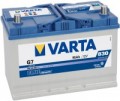Battery capacity
The electrical capacity of a battery, in other words, the amount of energy stored by a battery when fully charged. The capacity value is expressed in amp-hours and indicates the number of hours during which a fully charged battery will be discharged to the minimum allowable charge, delivering a current of 1 ampere to the load. For example, a capacity of 40 Ah means that the battery is capable of delivering a current of 1 A for 40 hours, or 2 A for 20 hours, etc. In fact, a more capacious battery gives more attempts to start the engine, and is also able to work longer at a low load (for example, when powering a car audio system).
The capacity requirements for different transport types differ markedly. So, in motorcycle batteries, it rarely exceeds 20 Ah, the average value for passenger cars is 40-80 Ah (but there are options for 100 Ah or more), and for heavy equipment like buses, an acceptable capacity starts somewhere from 100 Ah. The optimal value of the battery capacity is often indicated by the manufacturer in the characteristics of the vehicle, and when choosing a model by capacity, you should focus primarily on these figures.
Starting power (EN)
The starting power of the battery, measured according to the EN standard (the unified standard of the European Union). According to this standard, the starting power is the maximum power that the battery can deliver for 30 seconds at an electrolyte temperature of -18 °C without the voltage dropping below a certain level (for standard 12 V batteries - not lower than 7.2 V). The term "starting" appeared because this operating mode is similar to starting an engine, when the battery has to deliver a high-power power to the starter for a short time.
The recommended starting power value is generally related to the weight category of the vehicle: the heavier it is, the more powerful the power usually needed to start it. And many manufacturers directly indicate the recommended values in the characteristics of a particular vehicle model. If the battery is purchased as a replacement, the general rule is: its starting power should be no less than that of its predecessor.
Note that in practice, starting power designations may be encountered according to 3 more standards: SAE (USA), DIN (Germany) and TU (GOST 959-91). The first is almost identical to EN, and DIN and TU are quite easy to translate into EN and vice versa: they are similar to each other, and each of them gives a number approximately 1.7 times smaller than NE. That is, for example, to replace a 200 A battery according to TU, you should look for a model with a power of at least 340 A (200 * 1.7) according to EN.

